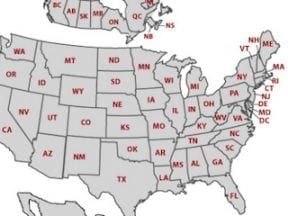The decision to sell to consumers or businesses has implications not just for marketing and inventory, but also for database management.
B2C customer data typically includes first name, last name, physical address, email address, and telephone number. In contrast, B2B data can include company name, title, store location, and warehouse details. A B2B merchant may ship to one store or many. The latter could require parent-child relationships — head office and branches — that will likely necessitate data hierarchies and, potentially, multiple tables.
The decision to sell to consumers or businesses has implications not just for marketing and inventory, but also for database management.
B2C data frequently includes demographic info, such as the customer’s age, household income, and gender. But B2B companies can track a customer’s annual revenue, industry, locations, and the number of employees. B2C sellers might segment customers by the purchase frequency or type of products. B2B sellers could segment by industry and number of locations.
Both types of sellers, B2C and B2B, store similar order information. It includes details such as product name, date ordered and shipped, and product price, including any discount. The discount could differ for B2B customers, however, as prices frequently vary depending on the order quantity and other details.
For example, a B2B seller may price the first 10,000 units at 80 percent of the manufacturer’s suggested retail price, the next 10,000 units at 70 percent of the MSRP, and orders above 20,000 units at 60 percent. In that instance, a B2B seller would likely account for all units in each order to apply the discount.
A B2C merchant may simply apply a coupon code for free shipping or a percent off. This could require the merchant to track the marketing effectiveness of that coupon promotion.
There could be other B2B data needs, such as storing user permissions to view or edit, attachment of legal documents, notes of sales conversations, the treatment of refunds and returns, and more.
Combining B2B Data into B2C
So how can a merchant add B2B info to an established B2C database? Mapping all of the data and its use is the first step.
The implementation will differ depending on the tool. For example, Salesforce is geared toward B2B. It has solved the problem of establishing a parent account (head office) and child accounts (branches, warehouses, retail locations). But a marketing automation tool may have just one simple table that stores all contact information without the ability to establish hierarchies.
Mapping all of the data and its use is the first step.
Regardless, follow these five tips for a smooth addition.
- List all data that you have collected or would want to collect for B2B and B2C. Map the data and its relationships and interactions with each other to visualize an overall understanding.
- Establish a field or flag that separates B2B and B2C data. This is important. You can separate further with secondary B2B fields, such as client versus prospect, or national chain versus single location.
- For B2B, separate head-office information from its retail locations. This is often difficult for B2C tools, which typically do not include such relationships within the same contact record. A workaround is to add another field for head office location versus retail or warehouse. Another field could include the name of the head office.
- For basic contact information (email, phone, address), use the same fields regardless of B2B or B2C. Create additional fields for B2B customers such as title (C.E.O., buyer), type of contact (marketing manager for promotions, warehouse manager for shipments, buyer for purchases), and company name.
- For demographic and company data, separate fields for B2B versus B2C to make it easier to access — for sales reps, analysts, and marketers. If you have multiple contacts for the same company in a B2C tool or a simple table, make sure that the company information is identical for each of those contacts.
Start with B2B Tool
B2B data is typically more complex than B2C. Thus it is easier to add B2C data into a B2B tool. If you are getting started and plan to sell to both types of customers, go with a B2B platform, even if it costs more.
If you use a B2C platform, you can still combine B2B data. It will likely require extra inputting and, also, copying data to each record. And it calls for careful diligence to maintain data integrity, such as the same company name for all related records.
I’ve seen merchants separate B2C data from B2B and store it in different places. This can make it easier for your personnel. However, if the same staff works on both B2B and B2C and you are on a budget, it may not be feasible to pay for two datasets and to train your team on both. Regardless, it’s possible to keep different types of info in the same data structure with proper formatting and governance.




